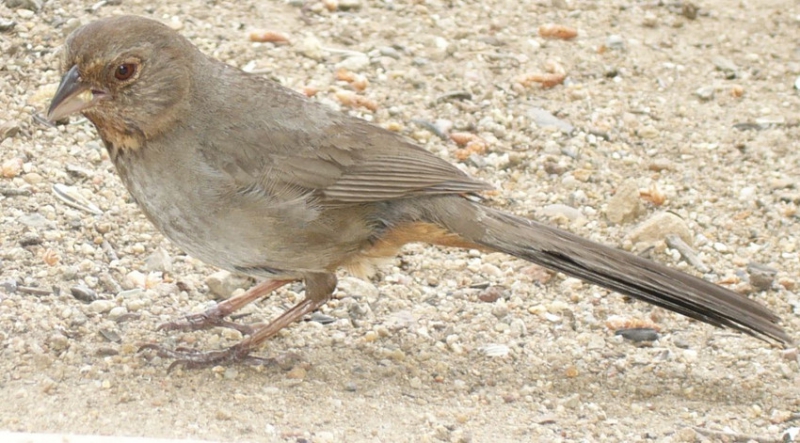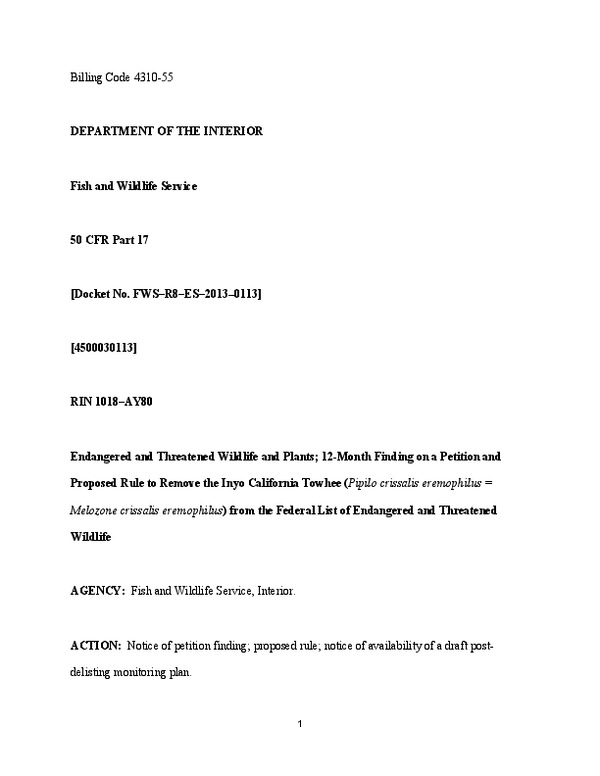From the Open-Publishing Calendar
From the Open-Publishing Newswire
Indybay Feature
Endangered Species Act Saves Once-threatened Mojave Desert Bird
LOS ANGELES— The U.S. Fish and Wildlife Service announced today (see PDF) that Endangered Species Act protections have successfully recovered the Inyo California towhee, a songbird found only near springs in the Mojave Desert. The towhee got federal protection in 1987 because its habitat around desert springs was being damaged by grazing, recreation and mining. Federal listing with critical habitat protection allowed the bird’s population to rebound from fewer than 200 birds in 1987 to more than 700 birds today.
“The recovery of this California songbird is the direct result of the Endangered Species Act, which has prevented the extinction of 99 percent of the plants and animals under its care,” said Tierra Curry, a biologist at the Center for Biological Diversity, which has worked to protect the towhee’s habitat for more than a decade. “The recovery of the towhee and its spring habitats is cause for celebration and provides yet another example of the success of our most important law for saving wildlife.”
The 7-inch-tall, gray-brown bird is found only in the Argus Mountains in Inyo County and nowhere else on Earth. In 2008 the Service published a five-year review announcing that Endangered Species Act protection had led to the bird’s recovery and that it no longer needed federal protection; today’s proposed rule to remove the bird from the endangered species list opens a public-comment period, after which a final rule will be published.
The bird needs trees near water sources to protect it from the desert sun and from predators, as well as for nesting. The vast majority of the towhee’s range is publicly owned land under the control of the Department of Defense, Bureau of Land Management and California Department of Fish and Wildlife; only 1 percent of its habitat is on private land.
The Center entered into a settlement with the BLM in 2001 to gain greater protection for the towhee’s habitat. The settlement enacted mining prohibitions, grazing restrictions, removal of feral burros, off-road vehicle restrictions and road closures.
In 2010 the Service entered into an agreement with public-land managers to carry out conservation measures to ensure the bird’s habitat continues to be monitored and protected. The measures include ongoing removal of feral burros, fencing to protect riparian vegetation, regulation of recreation and removal of non-native plants. Once the proposal is finalized and the bird is removed from the endangered species list, a federal monitoring plan will go into effect to ensure its continued recovery.
“Endangered Species Act protection with designated critical habitat is the most powerful tool our country has to save imperiled wildlife from extinction. Forty years after the Act’s passage, the story of the Inyo California towhee demonstrates how effective the law continues to be at preserving our irreplaceable natural heritage,” said Curry.
Photo: Alan Vernon
http://www.biologicaldiversity.org/news/press_releases/2013/inyo-california-towhee-11-01-2013.html
http://www.biologicaldiversity.org/
The 7-inch-tall, gray-brown bird is found only in the Argus Mountains in Inyo County and nowhere else on Earth. In 2008 the Service published a five-year review announcing that Endangered Species Act protection had led to the bird’s recovery and that it no longer needed federal protection; today’s proposed rule to remove the bird from the endangered species list opens a public-comment period, after which a final rule will be published.
The bird needs trees near water sources to protect it from the desert sun and from predators, as well as for nesting. The vast majority of the towhee’s range is publicly owned land under the control of the Department of Defense, Bureau of Land Management and California Department of Fish and Wildlife; only 1 percent of its habitat is on private land.
The Center entered into a settlement with the BLM in 2001 to gain greater protection for the towhee’s habitat. The settlement enacted mining prohibitions, grazing restrictions, removal of feral burros, off-road vehicle restrictions and road closures.
In 2010 the Service entered into an agreement with public-land managers to carry out conservation measures to ensure the bird’s habitat continues to be monitored and protected. The measures include ongoing removal of feral burros, fencing to protect riparian vegetation, regulation of recreation and removal of non-native plants. Once the proposal is finalized and the bird is removed from the endangered species list, a federal monitoring plan will go into effect to ensure its continued recovery.
“Endangered Species Act protection with designated critical habitat is the most powerful tool our country has to save imperiled wildlife from extinction. Forty years after the Act’s passage, the story of the Inyo California towhee demonstrates how effective the law continues to be at preserving our irreplaceable natural heritage,” said Curry.
Photo: Alan Vernon
http://www.biologicaldiversity.org/news/press_releases/2013/inyo-california-towhee-11-01-2013.html
http://www.biologicaldiversity.org/
Add Your Comments
We are 100% volunteer and depend on your participation to sustain our efforts!
Get Involved
If you'd like to help with maintaining or developing the website, contact us.
Publish
Publish your stories and upcoming events on Indybay.
Topics
More
Search Indybay's Archives
Advanced Search
►
▼
IMC Network





